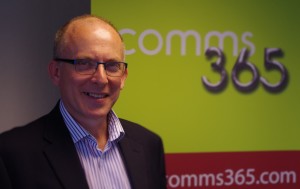
In this article, Nick Sacke, Head of IoT and Products at Comms 365,
clears up some industry wide confusion around IoT and its
associated buzz words of the moment.
If you have been in the communications business for a while you almost certainly will have come across the term ‘Machine-to-Machine’ (M2M) communications. If you sell IT solutions (who doesn’t these days), you will certainly have heard about the latest buzz-word, the ‘Internet of Things’(IoT). And, if you have been reading an awful lot, you may indeed have come across another concept, the ‘Internet of Everything’ (IoE)? Trouble is, these terms seem to be bandied about more and more frequently by analysts, CTOs of very large technology houses, and journalists who are looking to move market opinion toward their point of view, and in the process, many of us (myself included), get confused watching a moving target. Many of us are trying to work out how and where these 100-mile wide terms fit, and how one might approach using them for our single important job as resellers: designing and delivering solutions, value and outcomes to customers. Let’s start with the definitions to see if some sense and order emerges, and apply our knowledge to real-world customer examples.
Machine-to-Machine (M2M) initially referred to a system of point-to-point communications between objects (machines). With the expansion and availability of IP-based networks, M2M now covers a range of technologies and methods to enable device-to-device communications between machines, without active human involvement. Examples of where M2M is applied include warehouse management, remote control, robotics, traffic control, logistic services, supply chain management, fleet management and telemedicine. Many consider M2M today to be a subset of IoT. One of the tangible M2M services we Telecoms and IT folk are familiar with is the Mobile Data Fixed IP SIM, which is used to enable M2M communications. A more recent entrant is Low Power Wide Area Networking (LPWAN) which extends the reach of the M2M network even further and more cost-effectively to millions of devices.
The Internet of Things (IoT) refers to the interconnection via the Internet of computing devices embedded in everyday objects, enabling them to send and receive data. The critical word here is ‘embedded’, because this refers to a method of augmenting previously unconnected physical objects with computer chips, sensors and control systems, enabling a communications process of collecting and receiving data across a network of hitherto ‘dumb’ objects. Examples of this are ‘smart’ meters in cities, the connected car, and others. The term also applies to new digital devices such as wearables that are shipped with the embedded communications technology already enabled.
A very popular application and subset of IoT is Industrial IoT (IIoT) which is the active use of the technology in manufacturing, and other industrial uses. Examples of IIoT in action include building automation (lighting, energy use, security), ‘smart’ maintenance (such as preventing breakdowns in critical equipment to reduce downtime), and automation (the ‘Robot Factory’ that we see in large scale production and distribution). Accenture (2015) project that IIoT alone has the potential to generate $10 trillion+ to global GDP.
The Internet of Everything (IoE) is the new entrant to the Things melee. The concept originated at Cisco, who (initially for marketing purposes) defines IoE as “the intelligent connection of people, process, data and things.” In a nutshell, IoE is the whole Ecosystem of everything IoT and its’ daughter, M2M. Exploring further, ‘People’ may refer to the end-points that connect us to the internet to share our unique information (e.g. social and health networks). The ‘Things’ we already know to be our sensors, devices and actuators generating and/or receiving data. ‘Data’ is the sensor output analysed and displayed in useful ways such that we may be able to make a decision (for example, daily/weekly temperature logs from a fleet of machines used to craft a preventative maintenance programme). ‘Processes’ refers to leveraging the networked things, the data and people to add value (an advertising campaign about health, focusing on where to walk in a ‘dirty air’ city environment could be driven by outputs by wearables co-ordinated with social networks).
Are we any clearer on the ‘Things’ hierarchy and how to apply it to customer requirements? Perhaps. The final point to make is that the pace of evolution with this technology is speeding up, spawning even more acronyms: Internet of Health, Internet of Humans, Internet of Digital. None of these are as important as the tried and tested project approach where we consult with our customers, determine requirements, build a proof of concept, and pick the most appropriate mix of technologies and communications from a powerful and effective ecosystem of partners to deliver the measurable outcome. Stick to this approach, and you too could become a ‘Lord of the Things’!

